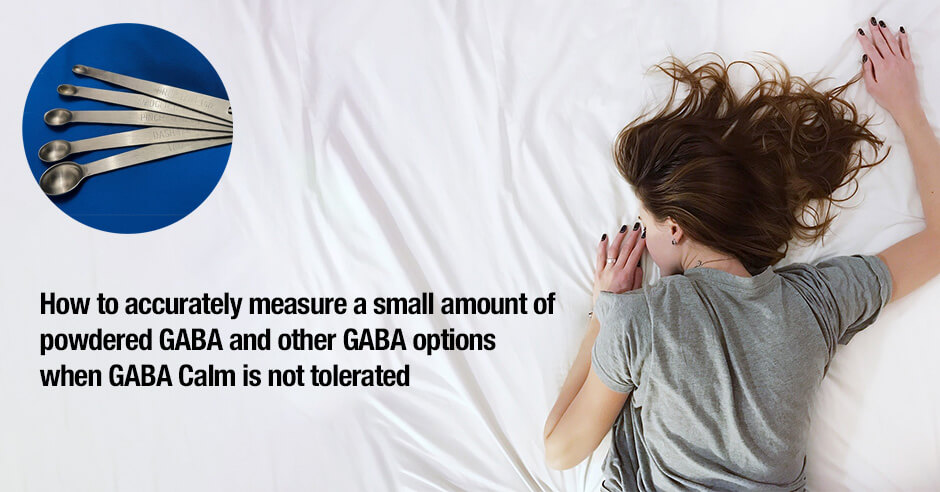
Brenda finds one GABA Calm helps her sleep but more than one affects her sleep and she suspects the sugar alcohols in the product. She’d like advice on using an alternative and how to accurately measure a small amount of powdered GABA. Here is her question in her own words:
I have been on the FODMAP diet for a while and it is helping but I just realized that when I take GABA Calm I am ingesting sorbitol and mannitol. I take a bit more than one of those tablets each night to help me sleep and am very aware that if I take too much it can keep me awake.
Now that I have realized about the sorbitol and mannitol, I am looking for an alternative source of GABA. I see that you are now recommending the Now GABA Pure Powder product. I was about to purchase this to avoid the sorbitol and mannitol but then realized that I would have to take 1/16th teaspoon of the powder to equate to 150mg. I can’t see me ever getting that measurement correct.
So my question is, can you recommend another source of GABA that would enable me to take 150mg plus a little bit with a fair degree of accuracy and without those added FODMAPs? Thank you very much. I am very grateful for your work.
Brenda has likely been diagnosed with SIBO (small intestinal bacterial overgrowth) or IBS (irritable bowel syndrome) even though she doesn’t mention it. In some folks with SIBO or IBS, sugar alcohols such as xylitol, sorbitol and mannitol can cause digestive upset. Not everyone with SIBO or IBS has issues with GABA Calm. In fact, it’s typically very well tolerated and GABA Calm is a product I have been recommending for many years. However, some folks do have issues and it’s wise to look for an alternative and not push through.
In this blog I share more about sugar alcohols, how to accurately measure out 1/16 teaspoon of the GABA powder to equate to close to 150 mg, how I use my mini measuring spoon, a GABA/theanine product that is low dose and can be opened, and another option she could consider.
Sugar alcohols in GABA Calm and other GABA chewable products
Many of the chewable or sublingual forms of GABA, including GABA Calm contain sugar alcohols which can be problematic and cause digestive upset and often explosive diarrhea. The digestive upset alone could impact sleep.
Sugar alcohols include xylitol, sorbitol, mannitol and erythritol. Your reaction will depend on the amount of sugar alcohols used, how many chewable/sublingual tablets you use and how accustomed you are to sugar alcohols. You may get used to them and eventually be fine with consuming small amounts and yet for others the tiniest amount is an issue.
I share more about sugar alcohols on this blog: Why does chewable GABA make me run to the bathroom and what GABA do I use instead?
Using a mini measuring spoon set and GABA powder
It’s wonderful that GABA Calm is helping Brenda with her sleep issues and when we start to get benefits we do want to increase the amount to see if we can get further benefits.
She has a few options and one is to use the NOW GABA powder (or another GABA powder) with a mini measuring spoon set like this one (my Amazon link). This is mine and it is very easy to use, convenient and accurate.
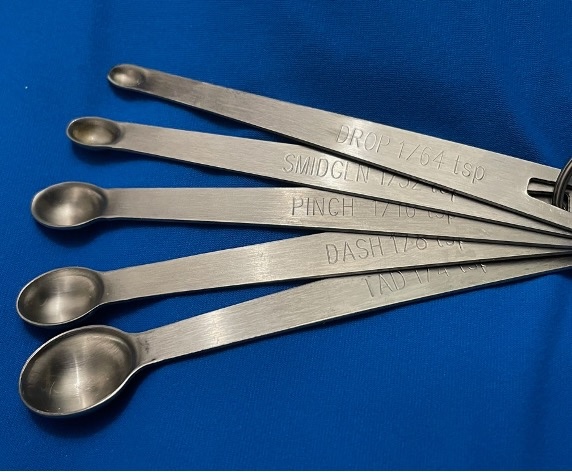
As you can see it comes in various sizes: 1/4 teaspoon, 1/8 teaspoon, 1/16 teaspoon, 1/32 teaspoon and 1/64 teaspoon.
It is important to look at the product and work out how much you need to measure out. For example, the NOW GABA powder states 1/4 teaspoon is equivalent to 500 mg GABA. This means 1/16 is equivalent to 125 mg GABA. So if Barbara wants to take 150 mg she would use a little more than what would be in the 1/16 spoon (maths is coming in handy after all!)
Keep in mind that product equivalents do differ. For example tryptophan is typically lighter and fluffier than GABA. My tryptophan states 1 teaspoon is 1000 mg tryptophan so a typical starting dose of 500 mg tryptophan would be 2 x 1/4 teaspoon since each 1/4 is 250mg.
I love my mini measuring spoon and use mine on a daily basis for theanine in the day, calcium citrate after dinner (for my oxalate issues), and for GABA and tryptophan at bed time.
Combined GABA and theanine: GABA-T SAP as one option
Another option is using a lower mg GABA/theanine product and opening it. Nutritional Fundamentals for Health GABA-T SAP is another favorite of mine. This product is pleasant-tasting when opened on to the tongue and works very well when GABA Calm can’t be used. It contains 300 mg GABA and 150 mg theanine, so can easily be halved to provide the 150 mg GABA she is looking for.
Research shows that the combination of GABA and theanine may improve sleep: GABA and l-theanine mixture decreases sleep latency and improves NREM sleep. The authors share the sleep and anxiety benefits of both GABA and theanine:
γ-Aminobutyric acid (GABA) is the main inhibitory neurotransmitter and it is well established that activation of GABAA receptors favours sleep.
l-Theanine, a naturally occurring amino acid first discovered in green tea, is a well-known anti-anxiety supplement with proven relaxation benefits.
But Barabra is going to have to do a trial to see if this combination works for her.
Mixing and matching as an other option
And finally, if she was also taking GABA Calm in the day for stress and overwhelm, she could do a trial of using this during the day (for the convenience factor) and then at night use the GABA powder or opened GABA/theanine capsule (because it’s a bit more finicky). This way she’s consuming less sugar alcohols overall.
Both GABA products, the mini measuring spoon set and where to find them
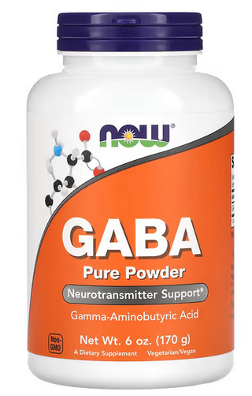
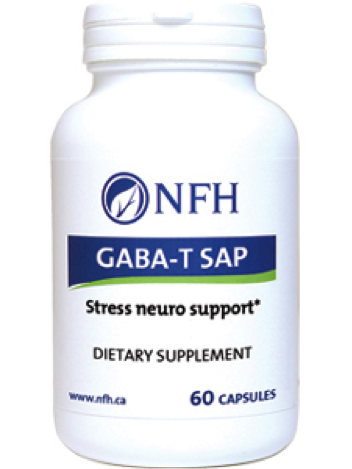
Today I mentioned the Now GABA Powder and NFH GABA-T SAP. You can purchase these from my online store (Fullscript – only available to US customers – use this link to set up an account).

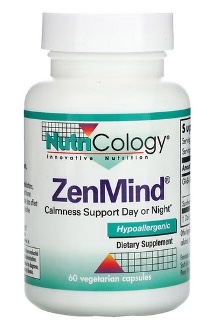
If you’re not in the US, the Now GABA Powder and Nutricology ZenMind (a GABA/theanine combination comparable to GABA-T SAP) is available via iherb (use this link to save 5%).
And the mini measuring spoon set can be found here (my Amazon link)
Additional resources when you are new to using GABA and other amino acids as supplements
As a reminder, low GABA can cause physical tension, anxious feelings, feelings of panic and problems sleeping, as well as self–medicating with alcohol or carbs to relax or fit in. As always, I use the symptoms questionnaire to figure out if low GABA or other neurotransmitter imbalances may be an issue.
If you suspect low levels of any of the neurotransmitters and do not yet have my book, The Antianxiety Food Solution – How the Foods You Eat Can Help You Calm Your Anxious Mind, Improve Your Mood, and End Cravings, I highly recommend getting it and reading it before jumping in and using amino acids on your own so you are knowledgeable. And be sure to share it with the practitioner/health team you or your loved one is working with.
There is an entire chapter on the amino acids and they are discussed throughout the book in the sections on gut health, gluten, blood sugar control (this is covered in an entire chapter too), sugar cravings, anxiety and mood issues.
The book doesn’t include product names (per the publisher’s request) so this blog, The Antianxiety Food Solution Amino Acid and Pyroluria Supplements, lists the amino acids that I use with my individual clients and those in my group programs (over and above the GABA products I mentioned above).
If, after reading this blog and my book, you don’t feel comfortable figuring things out on your own (i.e. doing the symptoms questionnaire and respective amino acids trials), a good place to get help is the GABA QuickStart Program (if you have low GABA symptoms too). This is a paid online/virtual group program where you get my guidance and community support.
If you are a practitioner, join us in The Balancing Neurotransmitters: the Fundamentals program. This is also a paid online/virtual program with an opportunity to interact with me and other practitioners who are also using the amino acids.
Wrapping up and your feedback
I do always appreciate questions like this so keep them coming so I can share and educate further.
Now I’d love to hear from you – do you have issues with the sugar alcohols in GABA Calm or another chewable GABA product? (if yes which one?)
Did you move to a GABA powder and do you use a min spoon set? Or does another GABA product work for you?
Please share how GABA helps and how much helps you?
If you’re a practitioner do you use GABA powder and mini spoons with your clients/patients?
And please let me know if it’s helpful that I’m now including product recommendations and where to get them.
Feel free to share and ask your questions below.
So funny! I had these spoons for something else and use them for the Now GABA powder. These tiny spoons are handy for a lot of things.
J
Great to hear – how does GABA help you and how much do you use? Curious what you also use the spoons for?
You mention that gaba increases non rem sleep. By this do you mean deep sleep. I have idiopathic hypersomnia and also burning tongue. I was prescribed by a neurologist gabapentin and also use one gaba calm sublingual before bed(a previous suggestion of yours for burning tongue). My Oura ring (using bi-pap) tracks very little deep sleep. Do these two products have the same biologic effect. My tongue has gotten about 50% better but restorative sleep has not improved. Would increasing the gaba calm be advisable. My gabapentin dose is 100 mg. I am 75. I use amelodipine 75mg to reduce sleepiness during the days I go to work. Thank you for your emails. I love the science.
Christine
Great to hear GABA Calm helps your burning tongue. When GABA helps any symptom we also consider increasing to see if it will help further. A higher dose or another GABA only product (such as NOW GABA powder) may improve sleep issues.
I would also be looking at side effects from prescription medications (many affect sleep) and looking into other causes of non-restorative sleep: low serotonin, gluten, SIBO, parasites, oxalates, liver/gallbladder/bile issues, high cortisol, EMFs etc.
This is all so very new to me. What a wealth of information but also overwhelming. I realize I need to start with your book because I’m just jumping all around on your site which is great but I’m getting lost (my own fault lol). I just have one big question from reading all of this, by taking these amino acids is there any risk of permanently “messing up your biochemistry”? I’m not sure if that makes sense. Could taking any of these long term cause your body to not be able to make them on it’s own to where you would be dependent on them. I got here in looking for info on getting off of anti-depressants. I’m just wondering if taking these in place or in addition to, long term, for say depression, ever harm you?
Julie
Great question! They are addressing deficiencies/imbalances and there is no evidence the amino acids permanently mess up your biochemistry or cause harm. That said they only work when neurotransmitter levels are low and the ideal amount is used.
Starting with my book is really the best and then using the blog articles for more advanced topics. Do keep us posted
Thank you for your amazing work and education on Amino Acids! I recently bought a protein powder to add to my 5 year old’s smoothies who I suspect is low on seratonin. It is called Simply Tera’s Organic why protein. (Grass fed, 1 gm of sugar, 21 grams protein.) I didn’t realize until I brought it home that it has several amino acids in it. In two scoops of powder, which is one serving it contains 431 mg of Tryptophan and 720 mg of Tyrosine.
My 5 year old is not on any medication, but I personally am on 10 mg of Lexapro, an SSRI. I was shocked that there is no warning on the label or anything about possible interaction with SSRI’s. It is completely unsafe for me to have this protein powder? I was just going to add it to smoothies.
Thanks ahead of time for your amazing feedback.
Dana
No amino acids are added to a whey protein powder such as this. The company is simply listing the amino acids that naturally occur in whey. It could be compared to listing the amino acids in a piece of grass-fed steak which would not be an issue for someone on an SSRI.
I’m curious why you suspect your 5 year old is low in serotonin and what else is included in the smoothie? And if he/she eats protein sources such as grass-fed red meat/lamb/pork, wild fish, pastured eggs and chicken and dairy? (all of which are excellent for a growing child)
Hi Trudy. Thanks for the explanation! That makes a lot of sense. The reason I suspect low serotonin is because she has a major genetic factor as most family members on both sides have anxiety/depression/ or addiction issues. She is irritable constantly and sleeps horribly, and has since birth. Sensory is also an issue for her, so food is a struggle as well as socks, underwear, certain pants, etc. She won’t eat red meat, poultry, lamb, or fish 90% of the time. She doesn’t like eggs (I make them for her sister almost daily.) . She will eat lots of dairy which has been her saving grace. She CRAVES sugar and asks for it constantly. So far, just adding protein powder to smoothies, taking away most sweet items and treats, and educating her on the importance of meat has made visible improvements. She still has horrible sleep though, even with GABA calm and we do light therapy every morning. I admit that I also am very picky and don’t eat a lot of protein so I have told her we will do it together. Do you have any thoughts? I did the questionnaires on myself and I am low in every category. My daughter reminds me a lot of myself when I was a child and is very sensitive and perceives most things as catastrophic and/or very painful.
Dana
Wonderful about visible improvements and some of that is often related to protein intake and blood sugar stability. With someone not eating red meat, poultry, lamb, fish or eggs we always consider low zinc as it causes protein aversion and if a cofactor in making serotonin and other neurotransmitters.
The amino acids do help with sugar cravings and dairy cravings is often related to low endorphins (I also think low endorphins when I hear perceiving things as painful) but if it’s the only source of protein and not causing issues we leave it as is.
Thank you Trudy! I have been giving her extra zinc, but was wondering what is the general recommendation for how DPA is safe and also effective for a child around 6 years old, 45-50 lbs with low endorphins? Gaba doesn’t make a difference and I don’t see a huge difference with Tryptophan either.
Dana
I’m not aware of any studies on DPA with children but when someone is concerned we discuss free form amino acids and protein intake/improving protein digestion and overall diet as this can improve endorphins. Also exercise, massage, nature, laughter, hugs etc to improve endorphins.
Hi Trudy,
I tried GABA powder on my tongue, and it gave me an instant headache.
I took it for the ‘wired and tired’ feeling.
I also react to difficult emotional situations with a feeling in my tummy
like there are ants running around in there. It makes me feel really
uncomfortable, difficult to relax when that’s going on.
Suffice to say I have gut issues..that’s another story.
Is there something other than GABA that will help? Or should I persist,
this time taking a much smaller dose?
Thanks so much Trudy, love your work.
Warm regards
Rose.
Rosaria
Too much GABA can do that – using too high a dose or using it when GABA levels are not low. May I ask how much you used and which product?
Wired tired is not something we associate with low GABA typically. Uncomfortable tummy sensations and inability to relax is one we associate with low GABA. Which other low GABA symptoms do you have? https://www.everywomanover29.com/blog/amino-acids-mood-questionnaire-from-the-antianxiety-food-solution/
Thanks for your kind words
Thank you, Trudy! You are so helpful and I appreciate you taking your time to respond.
I didn’t have digestive issues with GABA Calm, but it did make my mouth feel somewhat like it was burning. It wasn’t severe but was uncomfortable enough I figured GABA Calm wasn’t the best option for me.
On a separate, but possibly related note, is there a potential link between low pregnenolone, scoring high on the Low GABA list of symptoms, and reacting very poorly (and strongly) to benzodiazepines? I noticed in my reading that both pregnenolone and benzodiazepines can function through GABA receptors in the brain. I figure it’s something to look into as part of my health journey.
Thanks!
Hi Tracy thank you for your advice I been following for years but now I take gaba twice a day, tryptophan at 9:00 pm and 5htp at lunch but still I sleep well but it is difficult to start sleeping . And then of course in the morning I feel tired what else can I do?
Al
I have clients increase tryptophan and GABA (one at a time) and consider GABA before bed too. We also look into high cortisol. Other factors include gluten issues, low blood sugar, SIBO, food sensitivities, EMFs, caffeine & sugar intake etc
If you feel you need guidance and support we’ll be running the next GABA Quickstart program early next year https://www.anxietynutritioninstitute.com/gabaquickstart/ Sign up to be notified of details